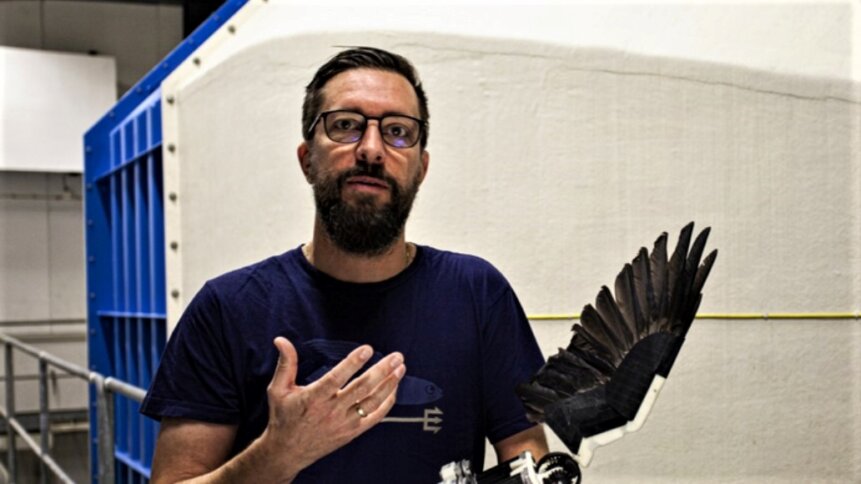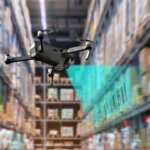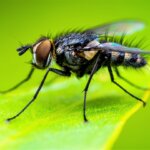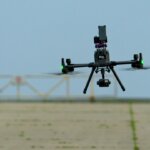Biohybrid flapping robot has drone appeal

|
Getting your Trinity Audio player ready...
|
Today, commercial drones have numerous industrial applications ranging from checking stock levels inside warehouses to monitoring the condition of wind turbines out at sea. Designs typically feature a series of motor-powered rotors that generate lift and allow the drone to hover. The propulsion sources are often arranged in a so-called quadcopter configuration, with two rotors at the front and two at the back. It’s a functional layout, but there’s room for improvement, which is where the concept of a biohybrid flapping robot fits in.
Replacing rotors with wings
Learning more about how birds fly – specifically, how they flap and fold their wings – has the potential, according to technologists, to revolutionize future drones. It’s believed that drones fitted not with rotors, as is common today, but with flapping, bird-like wings could enable uncrewed aerial vehicles (UAVs) to be more agile in flight. What’s more, biohybrid flapping robot designs could enable drones to fly more slowly, which could benefit monitoring or imaging applications. There are also likely to be gains in terms of aerodynamic performance.
The capability of birds to not just flap their wings, but also to fold and deform them makes their flight much more efficient. For example, they can reduce their body envelope on the upstroke, to lower drag, and then increase it on the downstroke to maximize lift. Drones fitted with foldable, bird-like wings could potentially travel much further on a single charge of their batteries compared with current designs.
Having established that fitting drones with flapping, foldable wings is a worthwhile strategy, the next step is to come up with a design. But birds flap their wings in many different ways, and what if developers wanted to go further and try to outperform nature? To answer these aerodynamic questions, researchers based at Lund University in Sweden and Ecole Polytechnique Fédérale de Lausanne in Switzerland have assembled a biohybrid flapping robot.
Studying force and energy in flight
“We have built a robot wing that can flap more like a bird than previous robots, but also flap in a way that birds cannot do,” said Christoffer Johansson, a member of the research team. “By measuring the performance of the wing in our wind tunnel, we have studied how different ways of achieving the wing upstroke affect force and energy in flight.”
When it comes to flying robots, much of the research that’s been conducted has focused on insect-like designs that have non-folding wings and move at very high frequencies. But – as mentioned – to access efficient flight, drone and UAV developers may learn a great deal from studying how birds fly, including how their wings deform and fold. Thanks to the robot wing – which features a microcontroller connected to folding, flapping, and pitching servomotors, and includes a differential gear system that is attached to a biomimetic element comprising primary and secondary feathers – scientists can recreate a wide range of movements.
The team used particle image velocimetry – a technique that compares differences between laser-illuminated sheets of light to infer movement – as a way of recording the aerodynamic wake. This data then allowed the group to back-calculate the aerodynamic forces and power generated by the various wing motions. “The new robotic wing can be used to answer questions about bird flight that would be impossible simply by observing flying birds,” Johansson points out.
Battery-boosting features
The Swedish-Swiss group isn’t the only one interested in making drones more bird-like. In 2018, scientists in Australia, in collaboration with researchers from the French Institute of Aeronautics and Space (ISAE-SUPAERO) unveiled a bird-like drone with flappable wings. In this case, the goal was to enable drones to operate for much longer periods of time than can be achieved using batteries alone.
As well as being able to flap its wings, the Australian-French design had the capability to sense gusts and thermals. Using the motion of the air in this way meant that the bio-inspired drone could accelerate and climb without drawing on its battery reserves. However, unlike the latest biohybrid flapping robot devised by the Swedish-Swiss team, the wings on the Australian-French design didn’t fold. The drone also featured a propellor placed at its nose, which could provide additional propulsion as required.
Birds have been perfecting their flight for millions of years. Fossil evidence suggests that familiar groups of species, such as ducks, swans, and eagles, could have evolved as long as 66 million years ago. So, it’s only to be expected that drone developers will take a few iterations to hone their designs. But once the lessons of avian flight have been learned, we could see bird-like drones that are even more nimble in the air than today’s quadcopters.
Thanks to their more efficient aeronautic properties, bird-like drones – which could include biohybrid flapping robot designs and other configurations – may be capable of not just staying in the skies for longer, but also traveling further on a single battery charge. This could add to the appeal of drones for transportation, an application that is likely to take off with the creation of so-called drone corridors or drone superhighways.










